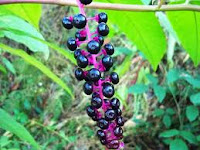Motherwort is a native of mainland Europe , but has become naturalized in the British Isles , as it was commonly grown in gardens for its medicinal properties. It is the only one of the Leonarus genus which grows wild now in the UK
It is a member of the Labiatae or Lamiaceae family of plants and as such is a relative of mint, marjoram, basil and Holy basil, oregano, savory, thyme, lavender, lemon balm, bugle and hyssop among many others. It flowers between July and September and is best harvested and dried for later use in August.
 Motherwort has been used in the past to flavour lentil and dried pea soups and a tisane may also be made from its flowering tops. However as Culpeper mentions, it tastes bitter and is best used in a conserve with honey or sugar to sweeten it.
Motherwort has been used in the past to flavour lentil and dried pea soups and a tisane may also be made from its flowering tops. However as Culpeper mentions, it tastes bitter and is best used in a conserve with honey or sugar to sweeten it. If you go near the plant be careful as it has sharp toothed edges which can cause injury to the mouths of grazing animals and hands. It has been known to cause dermatitis, and its essential oil can cause photosensitivity. It should be avoided during pregnancy. As its name suggests it has been mainly used as a woman’s herb for labour pains and childbirth, to promote menstruation and for nervous and hysterical disorders (it has a sedative action). Like borage, which tastes much better, it was used to gladden the heart and spirits, and was useful as a nervine and cardiac tonic. It was thought that it could keep evil spirits away, perhaps meaning that a person would not be overcome by melancholy.
Culpeper writing in the 17th century has this to say of its medicinal properties: -
“Government and virtues. Venus owns the herb, and it is under Leo. There is no better herb to take melancholy vapours from the heart, to strengthen it, and make a merry, cheerful, blithe soul than this herb. It may be kept in a syrup or conserve; therefore the Latins called it Cardiaca. Besides, it makes women joyful mothers of children, and settles their wombs as they should be, therefore we call it Motherwort. It is held to be of much use for the trembling of the heart, and faintings and swoonings; from whence it took the name Cardiaca. The powder thereof, to the quantity of a spoonful, drank in wine, is a wonderful help to women in their sore travail, as also for the suffocating or risings of the mother, and for these effects, it is likely it took the name of Motherwort with us. It also provokes urine and women's courses, cleanses the chest of cold phlegm, oppressing it, kills worms in the belly. It is of good use to warm and dry up the cold humours, to digest and disperse them that are settled in the veins, joints, and sinews of the body, and to help cramps and convulsions.”
In more modern times it has found a use in some thyroid treatments, and heart palpitations. The infusion can be made with one ounce of the fresh tops to one pint of boiling water left to steep before draining and drinking in small cupfuls three times a day. The alcohol extract of this plant is said to have an action superior to that of valerian.
It can be used as a diaphoretic to promote sweating, and in recovery from fevers. The tisane or infusion can help in cases of neuralgia and it was generally regarded as an excellent general tonic. However it is not much used these days.
























